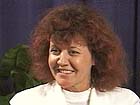 Shortly before this interview was held, Heliane Canepa was named president
of Schneider Worldwide. Ms. Canepa has been with Schneider almost
since it was founded in 1977, when it started manufacturing the first
angioplasty balloons for Andreas Gruentzig. This interview was conducted
in November 1996 by Burt Cohen.
Shortly before this interview was held, Heliane Canepa was named president
of Schneider Worldwide. Ms. Canepa has been with Schneider almost
since it was founded in 1977, when it started manufacturing the first
angioplasty balloons for Andreas Gruentzig. This interview was conducted
in November 1996 by Burt Cohen.
(Click here to access index of previous interviews.)
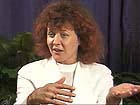 Q: Tell me what it was like working in the beginning days of angioplasty.
Q: Tell me what it was like working in the beginning days of angioplasty.
Canepa: Well, we started in a garage. We had a production team
of ten people. And, of course, there was no clean room. We made about
five catheters a week. And we were not allowed to sell one catheter
to a doctor who didn't show us a certificate from Andreas Gruentzig,
a training certificate. So, we had a window in this garage and we
opened it. We gave the catheter and we wanted cash — Swiss francs
— not U.S. dollars, no checks. And we sent the doctors back to the
bank so that they could bring Swiss francs. And at that time they
were very grateful, you know.
We didn't need
a marketing and sales department. We didn't have, of course, a clinical
or regulatory affairs, no lot number, no batch number. There was
the coffee, the cigarettes, and the cooking pot — we made the balloons
in there — and we were very proud when we had five pieces of catheters.
So it was not a big thing. We never thought that we'd grow that
much.
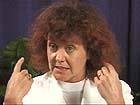 Q: You said you didn't have anyone in charge of regulatory. But
you did....
Q: You said you didn't have anyone in charge of regulatory. But
you did....
Canepa: Of course, it was Andreas.... Andreas was really a very
cautious man and he had a very cautious approach to it. He trained
all doctors on live cases. He was a very good teacher. And he didn't
allow us to sell [catheters] freely to everybody. He had absolute
control over what was going on. About all patients in every country.
They were all reporting to him. They were all giving him the data.
So he was the best clinical regulatory department we could ask for.
And, of course, our best marketing department too.
Q: What
was his motivation?
I think he just was a winner — a winner personality. And very
determined, very demanding. Got on our nerves sometimes. But fascinating.
He was obsessed with his invention. And he wanted it to work. He
was a very serious character, very good-hearted, but very demanding.
He just wanted things — like he wanted the prototypes, he wanted
it safe. He was a very technical person, so he could talk to our
engineers on a technical basis, which was very nice, of course,
because he knew materials, he knew what we were talking of. I think
he was just driven by his vision to have this thing going.
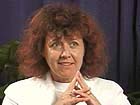 Q: In the beginning, who came?
Q: In the beginning, who came?
Canepa:
Those were the pioneers really, because the material was awful.
Today nobody would touch it anymore. It had no profile, no torquability,
pushability — all those words were not known! So there were really
cardiologists coming from all countries, really the pioneering cardiologists,
who believed in it. And there still was the fight going on against
surgeons because [the cardiologists] didn't get enough patients.
So in a lot of countries they couldn't even start, because the patient
was not there.
That was a
real pioneering group. And you could feel it. Innovative. I'm so
glad I was part of it then because this was really something, everybody...exciting.
Exciting things! It was not normal.
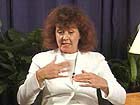 And the group was then growing bigger and bigger because Andreas
went to Atlanta, continued to do the courses there. And everybody
was going there. He was the only one and it was a lot of fun. The
patients were awake, Andreas talked to them, very nice with the
patient, you know. He said "Nice belly, nice cook." The patient
was waving after the procedure. It was this human atmosphere that
you have in the beginning of such a thing, and then it's loosening
up and it's getting more routine. And patients are sedated or not
part of it anymore, as in the beginning they were part of it.
And the group was then growing bigger and bigger because Andreas
went to Atlanta, continued to do the courses there. And everybody
was going there. He was the only one and it was a lot of fun. The
patients were awake, Andreas talked to them, very nice with the
patient, you know. He said "Nice belly, nice cook." The patient
was waving after the procedure. It was this human atmosphere that
you have in the beginning of such a thing, and then it's loosening
up and it's getting more routine. And patients are sedated or not
part of it anymore, as in the beginning they were part of it.
Q: You mentioned
the resistance against the procedure in the beginning. Does that
still exist?
There is no resistance, not the resistance we had in the beginning
of PTCA. On the contrary, now we have a program for beta radiation.
And everybody wants it. Everybody wants to be on the trials. So
we have much more response. People want to have something
different or new. So it's not like in the beginning.
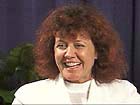 Q: What about the future of angioplasty?
Q: What about the future of angioplasty?
There is a lot to do, still to do. Carotids, neuroradiology,
aortic aneurysm, these are all places we have to do a lot of things.
So I don't think it will ever end. There will be always a place
to go with ideas. It's a fascinating, absolutely fascinating industry!
Back
to current "Featured Interview"
Go
to Interview Index
|
 Shortly before this interview was held, Heliane Canepa was named president
of Schneider Worldwide. Ms. Canepa has been with Schneider almost
since it was founded in 1977, when it started manufacturing the first
angioplasty balloons for Andreas Gruentzig. This interview was conducted
in November 1996 by Burt Cohen.
Shortly before this interview was held, Heliane Canepa was named president
of Schneider Worldwide. Ms. Canepa has been with Schneider almost
since it was founded in 1977, when it started manufacturing the first
angioplasty balloons for Andreas Gruentzig. This interview was conducted
in November 1996 by Burt Cohen.
 Q: Tell me what it was like working in the beginning days of angioplasty.
Q: Tell me what it was like working in the beginning days of angioplasty. Q: You said you didn't have anyone in charge of regulatory. But
you did....
Q: You said you didn't have anyone in charge of regulatory. But
you did.... Q: In the beginning, who came?
Q: In the beginning, who came? And the group was then growing bigger and bigger because Andreas
went to Atlanta, continued to do the courses there. And everybody
was going there. He was the only one and it was a lot of fun. The
patients were awake, Andreas talked to them, very nice with the
patient, you know. He said "Nice belly, nice cook." The patient
was waving after the procedure. It was this human atmosphere that
you have in the beginning of such a thing, and then it's loosening
up and it's getting more routine. And patients are sedated or not
part of it anymore, as in the beginning they were part of it.
And the group was then growing bigger and bigger because Andreas
went to Atlanta, continued to do the courses there. And everybody
was going there. He was the only one and it was a lot of fun. The
patients were awake, Andreas talked to them, very nice with the
patient, you know. He said "Nice belly, nice cook." The patient
was waving after the procedure. It was this human atmosphere that
you have in the beginning of such a thing, and then it's loosening
up and it's getting more routine. And patients are sedated or not
part of it anymore, as in the beginning they were part of it.
 Q: What about the future of angioplasty?
Q: What about the future of angioplasty?